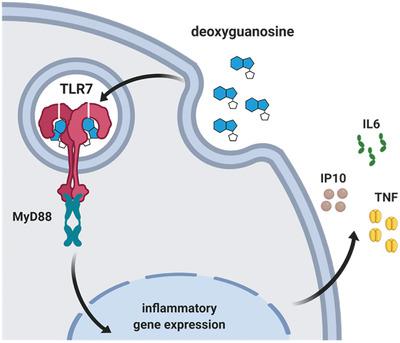当前位置:
X-MOL 学术
›
Eur. J. Immunol.
›
论文详情
Our official English website, www.x-mol.net, welcomes your
feedback! (Note: you will need to create a separate account there.)
Deoxyguanosine is a TLR7 agonist.
European Journal of Immunology ( IF 4.5 ) Pub Date : 2019-11-14 , DOI: 10.1002/eji.201948151 Tamara Davenne 1, 2 , Anne Bridgeman 1 , Rachel E Rigby 1 , Jan Rehwinkel 1
European Journal of Immunology ( IF 4.5 ) Pub Date : 2019-11-14 , DOI: 10.1002/eji.201948151 Tamara Davenne 1, 2 , Anne Bridgeman 1 , Rachel E Rigby 1 , Jan Rehwinkel 1
Affiliation

|
Toll-like receptor 7 (TLR7) is an innate immune sensor for single-strand RNA (ssRNA). Recent structural analysis revealed that TLR7 has an additional binding site for nucleosides such as guanosine, and is activated when both guanosine and ssRNA bind. The nucleoside binding site also accommodates imidazoquinoline derivatives such as R848, which activate TLR7 in the absence of ssRNA. Here, we report that deoxyguanosine (dG) triggered cytokine production in murine bone marrow derived macrophages and plasmacytoid dendritic cells, as well as in human peripheral blood mononuclear cells, including type I interferons and pro-inflammatory factors such as TNF and IL-6. This signalling activity of dG was dependent on TLR7 and its adaptor MyD88 and did not require amplification via the type I interferon receptor. dG-triggered cytokine production required endosomal maturation but did not depend on the concurrent provision of RNA. We conclude that dG induces an inflammatory response through TLR7 and propose that dG is an RNA-independent TLR7 agonist.
中文翻译:

Deoxyguanosine 是一种 TLR7 激动剂。
Toll 样受体 7 (TLR7) 是单链 RNA (ssRNA) 的先天免疫传感器。最近的结构分析表明,TLR7 有一个额外的核苷结合位点,如鸟苷,并在鸟苷和 ssRNA 结合时被激活。核苷结合位点还容纳咪唑喹啉衍生物,例如 R848,它们在没有 ssRNA 的情况下激活 TLR7。在这里,我们报告脱氧鸟苷 (dG) 在小鼠骨髓来源的巨噬细胞和浆细胞样树突状细胞以及人外周血单核细胞中引发细胞因子产生,包括 I 型干扰素和促炎因子,如 TNF 和 IL-6。dG 的这种信号传导活性依赖于 TLR7 及其接头 MyD88,不需要通过 I 型干扰素受体进行扩增。dG 触发的细胞因子产生需要内体成熟,但不依赖于 RNA 的同时提供。我们得出结论,dG 通过 TLR7 诱导炎症反应,并提出 dG 是一种不依赖 RNA 的 TLR7 激动剂。
更新日期:2019-11-14
中文翻译:

Deoxyguanosine 是一种 TLR7 激动剂。
Toll 样受体 7 (TLR7) 是单链 RNA (ssRNA) 的先天免疫传感器。最近的结构分析表明,TLR7 有一个额外的核苷结合位点,如鸟苷,并在鸟苷和 ssRNA 结合时被激活。核苷结合位点还容纳咪唑喹啉衍生物,例如 R848,它们在没有 ssRNA 的情况下激活 TLR7。在这里,我们报告脱氧鸟苷 (dG) 在小鼠骨髓来源的巨噬细胞和浆细胞样树突状细胞以及人外周血单核细胞中引发细胞因子产生,包括 I 型干扰素和促炎因子,如 TNF 和 IL-6。dG 的这种信号传导活性依赖于 TLR7 及其接头 MyD88,不需要通过 I 型干扰素受体进行扩增。dG 触发的细胞因子产生需要内体成熟,但不依赖于 RNA 的同时提供。我们得出结论,dG 通过 TLR7 诱导炎症反应,并提出 dG 是一种不依赖 RNA 的 TLR7 激动剂。









































 京公网安备 11010802027423号
京公网安备 11010802027423号